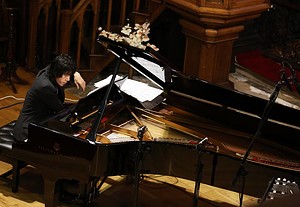Acclaim
Review
EMANATING SPARKS

At this year's Drogheda Arts Festival, Louth Contemporary Music Society presented a spectralist work from the 1970s alongside a postminimalist one from the last decade and a series of techno-inspired shorts. Brendan Finan finds the connections.
Drogheda Arts Festival is an annual early-summer festival devoted to a cross-section of the arts. This year, classical and contemporary music were represented by a concert at St Peter’s Church of Ireland on 5 May, organised in collaboration with Louth Contemporary Music Society. The main performer was pianist Taka Kigawa, playing works by Karen Tanaka and Tristan Murail, before being joined by percussionist Russell Greenberg (who recently performed with Yarn | Wire at the Music Current Festival) for the night’s featured work, John Luther Adams’ Four Thousand Holes.
Techno
The concert began with Japanese composer Karen Tanaka’s three Techno Etudes. As the name suggests, they were originally conceived to synchronise with existing techno music, but the composition seems to have taken on a life of its own for Tanaka. The techno was dropped, but its character remained, the music built on percussive beats, repetition, and speed. Kigawa’s playing was unexpectedly lyrical despite the fast tempos. The short, percussive phrases were finely shaped and defined, so that the three pieces felt as much as anything like remixes of Scriabin.
Ghosts of notes
Tanaka’s teacher, the French spectralist composer Tristan Murail, wrote the second work of the night. Territoires de l’Oubli (‘Territories of Oblivion’) is a sprawling work written in 1977, built on the natural harmonic resonance of the piano. The work is a paradox, seeming for long periods locked in place, while in constant motion, transitioning imperceptibly from section to section. At times repeated patterns stand like statues, vast and cold in the central register of the piano while harmonies broil above and below. At others, only the extremes of the instrument are used, low and high passages rumbling and flashing. The ending uses a trick of physics to achieve incredible beauty, the final note pulsing gently as it fades.
Kigawa’s playing was impressive – it had to be – but as extraordinary as it was to watch his fingers dance across the rapid, complex passages, the delicacy of his playing was even more striking. In quiet moments, he summoned the merest ghosts of notes, tiny pinpricks just a half-step above silence.
Emanating sparks
Four Thousand Holes is a very different work, but, like Territoires, it plants a harmonic seed from which to grow the music. In this case, the seed is the final, vast E-major chord from The Beatles’ A Day in the Life (the title comes from the lyrics of the same song), and related chords. The Beatles let the chord ring out for almost a full minute; Adams takes the chord and reverses it, so that it builds in intensity rather than fading over the same length of time. At its very peak, the piano enters, playing the same chord, the electronic sound becoming acoustic.
This is the virtuosity that the piece demands; it’s never as busy or technical as Territoires, but, for the musicians on stage, it is an act of supreme listening. Every chord must be precisely timed to arrive just as the electronics dictate. The percussionist responds to the piano as the piano responds to the electronics, sending up what Adams calls ‘sparks emanating from the piano.’ Greenberg’s performance on percussion was extremely well balanced with Kigawa’s, always clear without ever dominating.
Taking time
Adams’ work takes its time, and thrives in an extremely slow build to a grand peak. At the first climax of Four Thousand Holes, there was a palpable relief in the audience as the musical tension finally broke. I felt my muscles relax, without ever realising how taut they had become, and around me, I noticed several other patrons settle back in their pews.
At its conclusion, the music builds to an ecstatic peak, then returns to the bass register for a church bell-like peal around the E-major chord. Kigawa and Greenberg let the last chord ring out for a long time, and held still for a (welcome, necessary) half-minute’s silent reprieve before relaxing for applause.
Louth Contemporary Music Society, whose founder, Eamonn Quinn, was recently awarded the Belmont Prize for contemporary music, deserves the credit it gets for bringing extraordinary composers and performers to Ireland. More than that, it deserves recognition for its stylistic agnosticism; rarely does a concert feature a spectralist work from the 1970s alongside a postminimalist one from the last decade and a series of techno-inspired shorts. LCMS stands out not only for programming such works together, but for finding their inherent connections. - Brendan Finan, The Journal of Music, Ireland